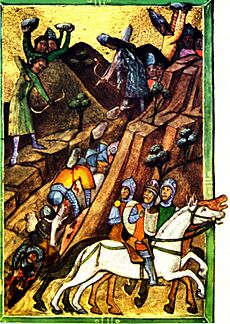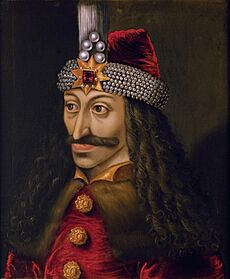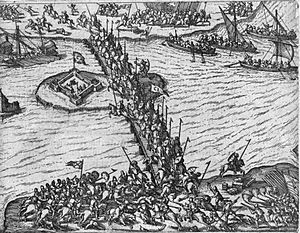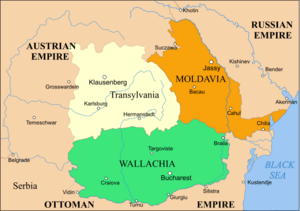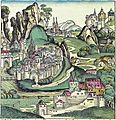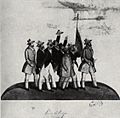Wallachia facts for kids
Quick facts for kids
Principality of Wallachia
Wallachia (Ţara Românească)
|
|||||||
|---|---|---|---|---|---|---|---|
| 1317–1862 | |||||||
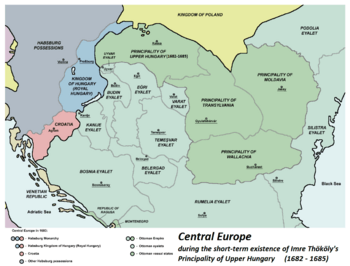 |
|||||||
| Capital | Câmpulung, Curtea de Argeş, Târgovişte, Bucureşti | ||||||
| Common languages | Romanian (commonly used, later official), Church Slavonic (in early official use) | ||||||
| Government | Principality | ||||||
| Princes of Wallachia (Voivodes, Hospodars) | |||||||
|
• 1310-1352
|
Basarab I - the first | ||||||
|
• 1859-1862
|
Alexander John Cuza - the last | ||||||
| History | |||||||
|
• Basarab I unifies the small voivodships in Wallachia
|
1317 | ||||||
|
• De Jure Union of the Danubian Principalities
|
1862 | ||||||
|
|||||||
Wallachia (also known as Ţara Românească, meaning "The Romanian Land") is a historical region in what is now Romania. It is split into two main parts: Muntenia (Greater Wallachia) and Oltenia (Lesser Wallachia). This area was once an important independent country called the Principality of Wallachia. It existed for over 500 years, from the early 1300s until 1862.
Contents
What Was Wallachia?
Wallachia was a principality, which is like a small kingdom ruled by a prince or "voivode." It was located north of the Danube River and south of the Carpathian Mountains. This location was very important for trade and defense. The land was fertile, good for farming, and had forests and rivers.
How Did Wallachia Begin?
Before Wallachia became a united country, there were many smaller areas ruled by local leaders. These areas were called "voivodships." Around 1310, a strong leader named Basarab I started to bring these smaller areas together. He is known as the founder of Wallachia. He successfully fought against the Kingdom of Hungary to make Wallachia truly independent.
Who Was Basarab I?
Basarab I was the first official Prince of Wallachia. He ruled from about 1310 to 1352. His most famous victory was the Battle of Posada in 1330. In this battle, his smaller army defeated the much larger Hungarian army. This win secured Wallachia's independence and showed that it was a strong new state.
Life in Medieval Wallachia
Life in Wallachia during the Middle Ages was mostly about farming. Most people lived in villages and worked the land. There were also important towns that grew because of trade. The main language spoken was an early form of Romanian. The official language for church and government was Church Slavonic.
What Was the Government Like?
Wallachia was ruled by a prince, or "voivode," who had a lot of power. The prince was chosen by a council of important nobles called "boyars." Sometimes, the position of prince was passed down in families. The boyars also helped the prince govern the country.
Important Cities and Capitals
Wallachia had several capital cities over its history. The first capitals were Câmpulung and Curtea de Argeş. Later, Târgovişte became the capital and was a very important center. Finally, Bucureşti became the capital and grew into the large city it is today.

Wallachia and the Ottoman Empire
For many centuries, Wallachia faced a big challenge: the powerful Ottoman Empire. The Ottomans were expanding their empire and wanted to control Wallachia. Wallachia often had to pay tribute (money or goods) to the Ottomans to keep its independence.
Who Was Vlad the Impaler?
One of the most famous (and feared) princes of Wallachia was Vlad the Impaler (Vlad Ţepeş). He ruled in the 15th century and was known for his harsh methods against enemies, especially the Ottomans. He became a legend and is sometimes linked to the story of Dracula. Vlad fought hard to keep Wallachia free from Ottoman control.
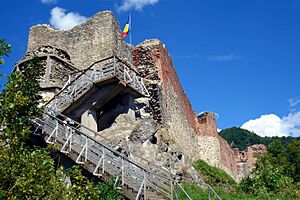
Michael the Brave and Unification
In the late 16th century, another important prince, Michael the Brave (Mihai Viteazul), tried to unite Wallachia with the neighboring regions of Moldavia and Transylvania. For a short time around 1600, he managed to bring these three Romanian lands under his rule. This was a very significant moment in Romanian history, even though the union did not last long.
The End of Wallachia as a Separate State
Over time, Wallachia, along with Moldavia, became more influenced by the Ottoman Empire and later by Russia. In the 19th century, there was a strong desire among Romanians to unite and form one country.
How Did Wallachia Join Romania?
In 1859, both Wallachia and Moldavia elected the same person, Alexander John Cuza, as their prince. This was a big step towards unification. In 1862, the two principalities officially merged to form the United Principalities of Wallachia and Moldavia. This new country was the beginning of modern-day Romania. Alexander John Cuza became the first ruler of this united land.

Wallachia Today
Today, Wallachia is not a separate country but a historical region within Romania. Its history, traditions, and famous leaders like Basarab I and Vlad the Impaler are an important part of Romania's national identity. Many cities in Wallachia, like Bucharest, continue to be major centers in Romania.
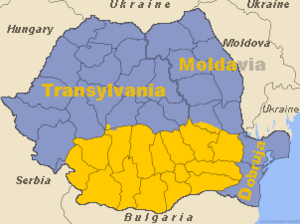
Images for kids
-
The seal of Voivode Mircea I of Wallachia from 1390, depicting the coat of arms of Wallachia
-
The territorial extent of the Second Bulgarian Empire under the reign of Ivan Asen II
-
Central and Southeastern Europe (including the Balkan peninsula) from the 15th to the 18th century
-
Welcoming of the Prince Josias of Saxe-Coburg-Saalfeld in Bucharest (1789)
-
1848 revolutionaries carrying an early version of the flag of Romania. The text on the flag can be translated as: "Justice, Brotherhood".
-
Territorial extent of the Principality of Wallachia (alongside neighbouring Moldavia and Transylvania) throughout the late Middle Ages
-
The Principalities of Moldavia and Wallachia in 1786, as depicted on an Italian map by G. Pittori (after the geographer Giovanni Antonio Rizzi Zannoni)
See also
 In Spanish: Valaquia para niños
In Spanish: Valaquia para niños




